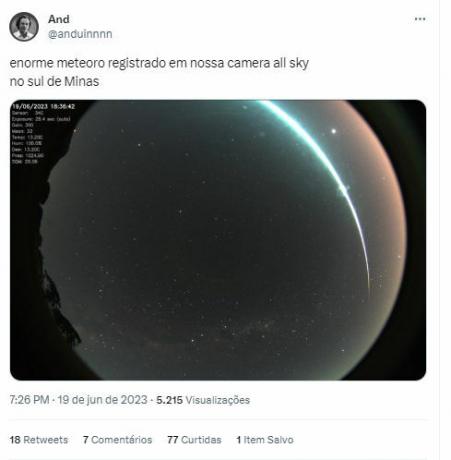Residents of the states of Minas Gerais, São Paulo and Goiás reported on social networks that they saw a meteor on the night of Monday, June 19.
Reports indicate that a luminous ball was seen in the cities of Mococa (SP), Barbacena (MG), Belo Horizonte (MG) and Pouso Alegre (MG).
According to the Brazilian Meteor Observation Network, it is a large bolide (large luminous meteor) that crossed the skies of the states in question and also in part of Paraná.
The Meteor Network reported that the bolide entered our atmosphere on June 19, at 6:37 pm.
Check out a post on a social network:

What is meteor?
Meteor is the term used to designate any luminous phenomenon resulting from the entry of matter into the atmosphere of planet Earth or any other planet. Such a phenomenon is commonly associated with solid meteors — fragments of comets or asteroids that receive this name when they approach the Earth's surface.
Due to the luminosity generated from their contact with the components of the atmosphere, which makes them visible to the naked eye, meteors are called shooting stars. The word meteor is derived from the Greek metéōros, which means "phenomenon in the sky".
Do not stop now... There's more after the publicity ;)
What to study about meteors?
Meteors are a phenomenon that can be addressed in geography tests for university entrance exams and the Enem.
See below what is important in meteor studies:
Meteor is a luminous phenomenon caused by the friction between a celestial body and the gases of the atmosphere. On Earth, it forms in the mesosphere layer;
It is also called a shooting star, visible to the naked eye;
When it passes through the atmosphere and reaches the ground, it is called a meteorite;
The solids that give rise to meteors can be rocky (aerolites), metallic (siderites) or mixed (siderolites);
Meteor showers happen when a very high number of fragments enter the Earth's atmosphere, forming several shooting stars at the same time.
Exercise on meteors
Meteor video lesson
By Silvia Tancredi
Journalist


